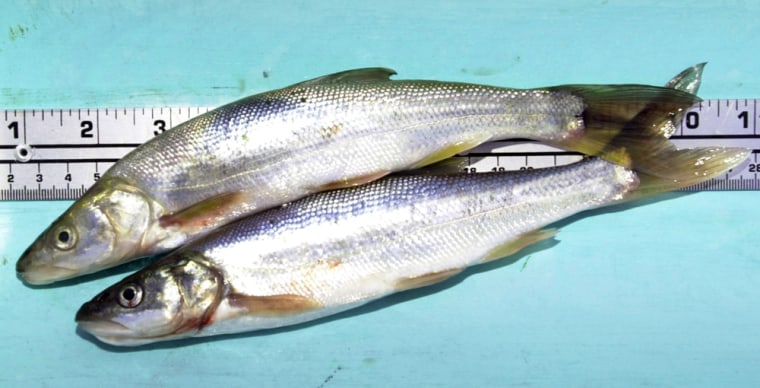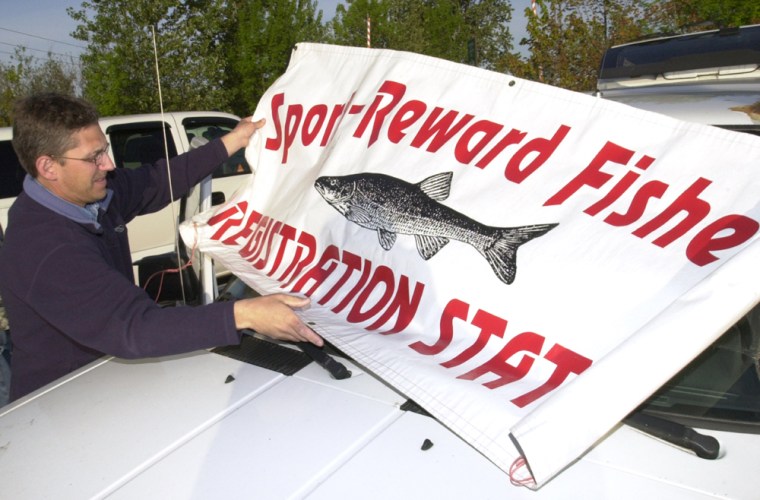On his first cast of the season, Jim Walker pitched a lure resembling a baby salmon into the dark green waters of the Columbia River and — BAM! — hooked a 24-inch fish with a $4 bounty on its head.
But alas, “we didn’t hook another one all day,” the 73-year-old retiree said.
It may not always be easy, but fishermen who can fill their coolers can also fill their pockets — some getting nearly $40,000 — for helping to control the most voracious predator of baby salmon in the Columbia Basin, the northern pikeminnow.
To help make up for the harm done to salmon by the government’s hydroelectric dams in Washington, Oregon and Idaho, the Bonneville Power Administration, a federal agency, is paying a bounty of $4 to $8 for each northern pikeminnow caught, as long as it is at least nine inches long.
There are also more than 1,000 specially tagged bonus fish worth $500 each scattered through the 450 miles of the lower Columbia and Snake rivers to attract more fishermen and help biologists gauge the effect of the bounties.
Fishermen have to turn in the pikeminnows to claim the bounty. The fish are then ground up into fertilizer. (An attempt a few years ago to turn them into fish sticks in Chicago proved a failure. Pikeminnows are not good eating; they are bony and the flesh is mushy and has little flavor.)
Over the years, federal, state and local governments have offered bounties on such creatures as coyotes, gophers, crows, skunks and swamp rats known as nutria. But this is believed to be the only federal bounty now being offered for fish.
Life threatening work
Folks who really work at it, 12 to 18 hours a day and seven days a week, can gross $20,000 during the May-to-October season. Two of the 1,800 people who collected bounties last year got paid close to $40,000 each.
“It does take a lot of work, and it does take some knowledge to really catch them consistently,” said Tim Caldwell, 46, who was 10th on the money list with $19,084 for 2,425 fish, two of them bonus fish. “I’m after it for the money.”

Caldwell has been bounty fishing since the program started in 1991, full-time since he sold his gas station and tackle shop three years ago. His best day was 141 fish, but when he got home he was as tired as he has ever been in his life, having gotten up at 2 a.m. and fished until 10 p.m.
“For some people this gets pretty competitive,” he said. “There’s been problems with people where they want to fight over spots to fish. I mean bad enough to get the police involved. I’ve actually had my life threatened.”
The “sport reward fishery” — the folks running the program do not like the term “bounty” — brought in 241,000 northern pikeminnows last year.
“A bounty is when you are trying to exterminate a species,” said Russell Porter, spokesman for the Pacific States Marine Fisheries Commission, which coordinates the program for the BPA. “We’re not trying to do that. We’re trying to restructure it.”
The dams slow down the river and bunch up the salmon, giving the pikeminnows a better shot at dinner. Also, the young salmon that go through the dams’ turbines or over the spillways are sometimes stunned, making them easier prey.
Large appetites
Researchers found that of all the big fish eating little salmon as they migrate to the ocean, the northern pikeminnow was the champ, far out-gobbling smallmouth bass and walleye. A big pikeminnow — they max out about 25 inches — will eat a half-dozen baby salmon a day.
Now the BPA spends $3.8 million a year keeping them in check.
That has not been enough to keep 14 populations of Columbia Basin salmon and steelhead off the threatened and endangered species lists, but it helps.
Oregon Department of Fish and Wildlife biologist Tom Friesen figures bounty fishing has reduced the number of salmon gobbled up by pikeminnow by 22 percent. That translates to about 3.8 million more baby salmon per year.
A 2004 economic impact report prepared for the Pacific States Marine Fisheries Commission estimates the extra fish generate $2.7 million to $9.9 million and 446 jobs from Alaska to California.
